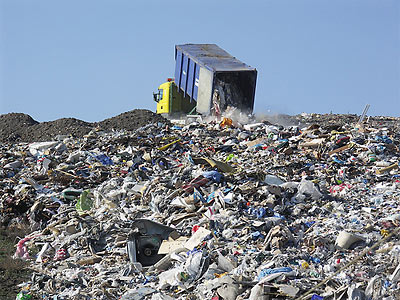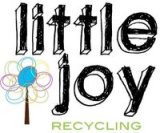 Photo:
Photo:
Use it, toss it, bag it, carry it to the curb and forget about it—this is the way most of us think about trash. Out of sight, out of mind. Get the garbage as far away as possible. Even the most adventurous children hold their noses and make excuses to avoid carrying those nasty trash bags to the curb (“But, Mom, I did it last week!”). Of course, nobody wants to live next to their refuse…nor should they, given the potential problems associated with exposure to harmful bacteria, heavy metals, and chemical contamination.
So, as we push discards out of our homes and into the waste stream, precisely what is the journey garbage takes from the curb to its final resting place? The only slightly dramatized tale that follows is more grubby than epic, more nauseating than whimsical, but a tale that nevertheless must be told: the tale of the trail of our trash.
CHAPTER 1: Truckin’ Through the ’Hood
Most homeowners have seen garbage trucks methodically making their way through the neighborhood, often with very sweaty men jumping on and off to hoist bulging bags or mechanical arms lifting overflowing bins into a chasm at the rear of the truck. Thus, the journey of trash begins with the solid waste collection vehicle—or in Britain, the quaint-sounding dustbin lorry—a rolling ferry transporting garbage away from the quiet solace of the shire to a land of, well, more garbage. Once secured by the collection vehicle, trash usually meets the wrath of a compactor to make room for its malodorous brethren. After collecting and compacting about six tons, the truck departs.
CHAPTER 2: A Stop on the Way
While many trucks simply make their way to a landfill, others stop at a trash transfer station. Transfer stations are a kind of trash purgatory, a transitional space between initial collection and final disposition. These garbage depots consist of a simple slab of concrete—a tipping floor with or without walls or covering—designed to allow large trucks to dump their load into a large pile, where it is once again compacted and then packed into larger trucks destined for the landfill. As you can imagine, the stench inside and surrounding such a site often proves unbearable. All this is before the vectors—rats, raccoons, roaches and the like—enter the scene.
CHAPTER 3: A Happier Place
However, our discards occasionally meet with a different fate. Some facilities provide an area separate from the tipping floor for common recyclables, an area for brush and yard waste (used for composting), an area for building materials or furniture or appliances, etc. When the essential function of a transfer station becomes waste diversion and retrieval rather than waste compaction and disposal, our rubbish has stumbled upon a materials recovery facility (MRF)—it still stinks, but the smell is tempered by the environmental and economic benefits of recovering rather than burying items of value. Here, recyclable metals, compostable organics, intact construction materials and reusable items ranging from paint to microwaves to bed frames to bicycles are separated from the refuse. Some MRFs even reach out to artists who can find aesthetic value in the unlikeliest junk, generating economic value in the process. (A footnote on the economy of waste recovery: a recent study conducted for the City of Austin found that the Capitol Region buries in landfills about $40 million annually worth of recoverable materials.)
CHAPTER 4: An Unpleasant Grave
Unfortunately, materials recovery facilities are a rare breed in Texas and throughout much of the country, which means that the journey taken by the vast majority of our trash ends with land disposal, buried in the ground. Trucks arrive from transfer stations or neighborhoods at the landfill gate, where they are weighed, sometimes inspected by a spotter perched above the scales (checking for illegal items such as freon-filled refrigerators) and then waved on to the working face. There, trash meets with more trash meets with menacing compactors—behemoth vehicles often equipped with massive spiked metal tires and a dozer blade—load after load, hour after hour until, finally, the waste is covered with six inches of dirt (or an alternative cover) at the end of the day. This process of burying and covering garbage to prevent contact with moisture is fittingly known as dry entombment. Within this trash mountain our refuse finds its final resting place. Or does it…
EPILOGUE: The Trail of Trash…To Be Continued
A number of studies show that even modern landfills with liners eventually leak, allowing household chemicals and heavy metals to leach into soil and nearby water sources. Garbage dumps are the largest source of human-caused methane emissions, a greenhouse gas twenty-three times more potent than carbon dioxide. Researchers have found high levels of mercury in some landfill gas intended for venting. The journey of our trash may not end with its entombment—it can come back to haunt us.
ALTERNATIVE ENDING
In many ways, the tale of trash is choose-your-own-adventure rather than scripted drama. Opportunities to divert our detritus from the trash trail exist at every turn in the story: we can purchase recycled and recyclable goods and separate them prior to putting them out on the curb, extend life-span by repairing and reusing old items, donate unwanted things like clothes and furniture to Goodwill or sign up with a group like Freecycle.org. Food and yard waste can go to a compost operation. Best Buy will recycle old TVs and computers. Even styrofoam has a more suitable resting place than the landfill: some local companies collect and sort a range of materials for foam recycling. This is the happier ending of the tale of the trail of trash…the ending that leaves no trail at all.
Jeffrey Jacoby, Staff Director, Texas Campaign for the Environment
Article originally published in August 2009 issue of House & Home Magazine
Filed under: Landfills, Recycling, Sustainable production & consumption | Leave a comment »
 from consumers, small business, schools, and local governments. Producer takeback recycling ends the existing system of local taxpayers subsidizing waste, shifting the cost of waste management from governments to producers. Producers have the control over design and should be responsible for the solutions. By making the producer responsible for their end of life products, there is a market-based incentive to start designing for reuse, recycling and with safer materials. In addition it levels the playing field to make it fair for everyone.
from consumers, small business, schools, and local governments. Producer takeback recycling ends the existing system of local taxpayers subsidizing waste, shifting the cost of waste management from governments to producers. Producers have the control over design and should be responsible for the solutions. By making the producer responsible for their end of life products, there is a market-based incentive to start designing for reuse, recycling and with safer materials. In addition it levels the playing field to make it fair for everyone.

 Photo:
Photo: 















